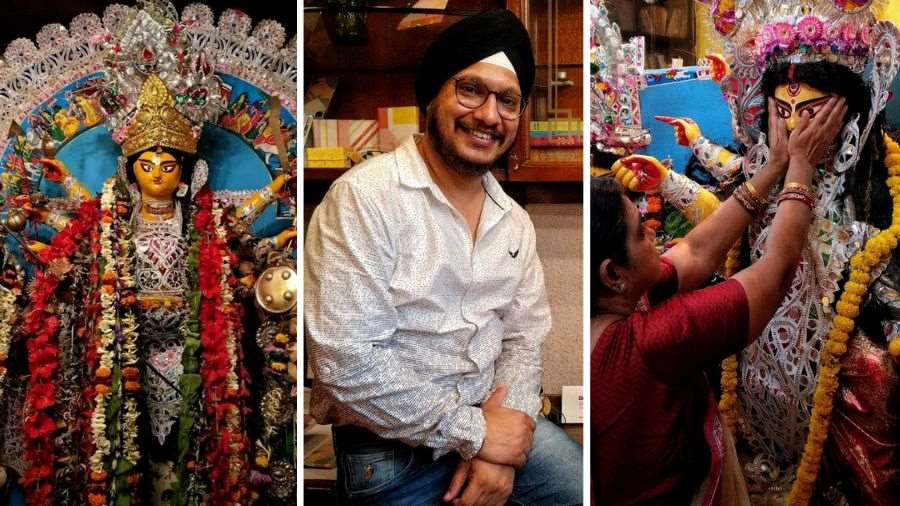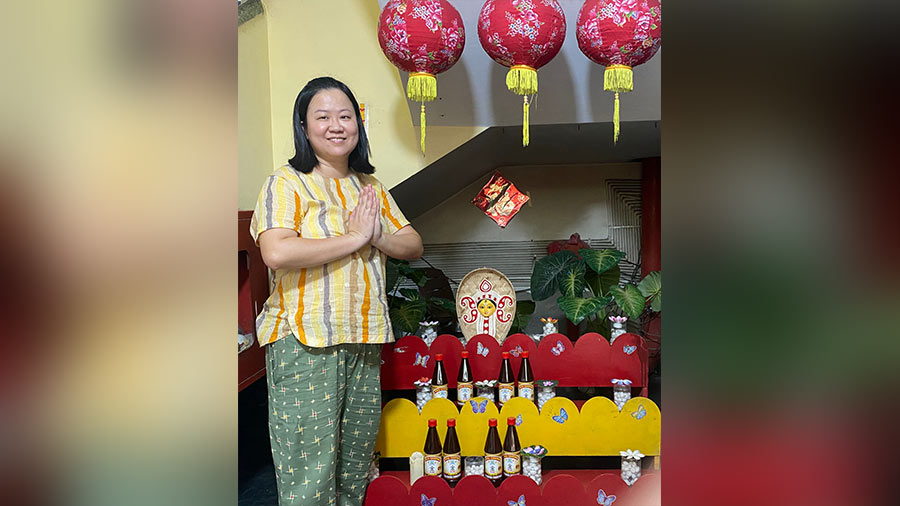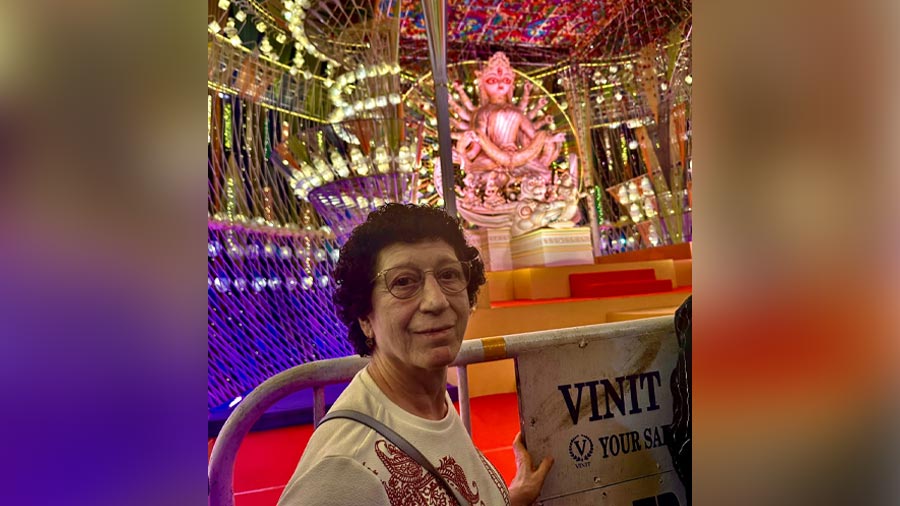Manjit Singh Hoonjan refers to himself as a tero ana Bangali, missing out on completing the full 16 because of his Punjabi name, his turban and the fact that he cannot read Tagore’s works in the original Bengali. Speaking fluently in Bangla, however, is not a problem at all for this third-generation Kolkatan from Bowbazar.
The first-generation Hoonjan, Manjit’s grandfather, came to Kolkata about 80 years back and began working as a carpenter. The narrow gullies of Bowbazar, where many paras are still named and arranged by erstwhile professions of its early residents, is where this Sikh family made a home in Kolkata. Three generations later, they are as much Kolkatan as they are Punjabi, with festivals and everyday life taking on the shades of both cultures.
For this Sikh boy from Kolkata, Pujo has been something he grew up with and more than anything else, it has been about the rituals and traditions associated with the festival. Pandal-hopping was hardly ever on the agenda in the past or now, but he tries his best not to miss the anjali or the Nabapatrika snaan.
When My Kolkata had a chat with Manjit on Mahalaya day, the internationally-published photographer and the man behind Calcutta Photo Tours had just returned from a two-month-long trip to the US. The change in timings and inevitable jet lag meant that he temporarily forgot that it was Mahalaya. At the end of the chat, he was still a bit troubled that it had slipped his mind — perhaps that shows what Pujo is all about for Manjit.
Growing up with a ‘barir pujo’
“For me Pujo has always been a traditional thing. The little bit of pandal- hopping that might happen is by virtue of family outings or because of my tours. Puja always began with the protima being made,” said Manjit. Growing up, he spent a long time at their neighbour’s home where the family has a Durga puja for over 50 years now. “We kids grew up together,” said Manjit, adding that back in that time, the families living beside and across from each other in these gullies were very tightly knit. He has memories of rushing home from school to check how much of the idol had been made. “When the maati and the khor came in for the kathamo, it was my signal that Puja was close.”
He has fond memories of this Puja, like hooking up LP players to speakers to play tracks from Yarana — “we were DJs before the concept even began”! As a kid, he had small pujo tasks like getting the pujo thala. “I would fast for sandhi puja, much to the befuddlement of everyone, and then I’d get special treatment and a feast after,” he laughed, reminiscing. The commercial aspect of Puja, even when it was smaller, escaped him completely because he wouldn’t really leave the house or the para. “Pujo ended with bisharjan.”
As he grew older, some pandal-hopping with college friends came into the scene. “When I started photographing, I would step out more and then go out with my family,” he added. Manjit’s wife is not from Kolkata and had heard a lot about the Kolkata Durga Puja. The first time he took her to see the pujas in the city, they went to Muhammad Ali Park because he “did not know any better!” A Metro ride later, they ended up joining a line doing the whole circuit finally emerging at College Square — the crowds and frenzy worrying his non-Kolkatan wife. Once the kids came along, they would “do the pandal- hopping thing” and visit a few big pujas, especially places that were kid- friendly.
Much later, when Calcutta Photo Tours started, he’d take some of his guests to a few pandals but still does not do pandal-hopping tours. “We get a lot of calls about those, and a few pandals will feature because people come from outside the country to see this, but it’s never the whole itinerary because I like to show my guests the traditions and rituals of Durga puja. So we do things like going to the ghats to see Kolabou snaan and Nabapatrika snaan,” he explained.
What Puja looks like today
Manjit is a regular presence at the barir pujo his neighbours have, and when he can make time in between tours, he’s usually present for all the rituals. When Manjit does not have a tour, he still goes with the family to Babughat for the kolabou snan. In fact, one year, his tradition even made news. “There was this whole article about a Sikh boy carrying the umbrella for kolabouo as they walked to the ghat.” He takes his guests along sometimes and they get an enthusiastic welcome because “people want to share their culture with those from outside the country”.
For the Hoonjan family, Puja does not include any special shopping since they “buy clothes when we need them” and the glow-up is usually reserved for Diwali. “My mother and wife, and the kids usually hang out with the neighbours. They will attend the arati and go for pushpanjali. Then, on Dashami, the neighbours will inform mom and my wife when it’s time for boron.”
Over the years, Manjit’s kids have also become part of the ceremonies. This year, his son is in Chennai studying and misses pujo at home — a feeling compounded by the muted celebrations of Navratri and Puja in southern cities. “I would sometimes find it annoying that people outside Calcutta have this yearly Pujo craving, but I also get it. My son loves photographing the city, too, and now I see the FOMO happening with him as well. You can take a Calcuttan out of the city but you cannot take Calcutta out of them. Even if someone is coming to the city just to stay in and sleep, everyone wants to be in Kolkata for Durga Puja.”
Changes and constants
Being a third-generation Kolkatan who grew up with Durga Puja, especially one he was so involved with, Manjit is much more immersed in the celebrations that his father or grandfather was. His grandfather moved to Kolkata alone, leaving behind his grandmother and father, who was still a kid then. Working as a carpenter primarily on government contracts meant Puja was when he got to take time off to visit family in Punjab. Manjit’s father came to Kolkata after completing high school. His experience was a little different because the neighbour’s Puja was new and he had friends of the same age in the house so he got involved with the Puja. But it was still just the two men in the house at that time.
“My grandmother moved here after my parents got married, so initially the two men would live their bachelor working lives here and take that time off to visit their families. Things changed when my mother and grandmother moved in.” The women were invited to join in the ceremonies of the Puja and it grew from there. In fact, Manjit’s mother is still referred to as ‘notun bou’. “She came here as a newly married young Punjabi girl who could not speak Hindi properly, and then she was slowly speaking broken Bangla,” he said, adding that the fact that he never left the city to work elsewhere also influenced his relationship with Kolkata and Durga Puja.
He now sees a lot of his childhood experiences play out with his kids. “My daughter has similar tasks — she helps with the prasad thala and other little things. In many ways she is following in my footsteps because she is part of the photography club at school, and documents each day of the festival. It feels really nice to see my childhood reflected in them.”
Durga Puja traditions
There are some traditions that Manjit has tried to hold on to over the years. Despite not being a fan of pandal-hopping, the one pandal he always does drop by is the one at Kumartuli. “I cannot remember the exact name, but it is the one on the ghat” — probably Kumartuli Sarbajanin — he mused later. He’s been going to Kumartuli for over 20 years now and for him it is like being in his own para pujo. “Everyone there — the people, organisers — know me. I have never had to stand in line because someone will spot me and take me in. It feels like my parar pujo because of the relationship I have with the people. I know a lot of photographers go there but they have never treated me as just another photographer because there’s years of relationships there,” he explained. One memory that stands out from that Puja is the year the theme was ‘Maati’, because it made him cry.
His Punjabi roots mean that sometimes there is an interesting amalgamation of rituals that happen and one such is on Ashtami. There is a custom of lighting a lamp or a jyot on Ashtami, after which the gurdwara-style kada prasad and puri-kala channa is eaten. For Pujo, Ashtami anjali is an important ritual. This led to interesting mornings in the Hoonjan household when Manjit was a kid. “On Ashtami, I would hear the dhaak and realise arati had started and pushpanjali would be soon. I would quickly bow before the jyot and someone would tie that thread around my wrist, but I would not have prasad because I was fasting for anjali. I’d run for anjali so I could finish that and come back to eat the puri-chana and prasad that I was waiting for,” he reminisced.
Some of the magic of childhood traditions are still present, or at least, he tries to keep them alive. There is a ritual of writing Sri Sri Durga Maa Sahay on bel leaves at the neighbour’s puja and all the kids would spend the morning hunting for the biggest, flattest leaves without holes to write on. “We still try to do that now,” laughed Manjit who has never missed a darpan bisharjan till date, whether he gets to hunt for writable leaves or not.
As many traditions do, another annual custom involves food. Where you would expect luchi or bhog being a Puja favourite and constant, Manjit’s Puja food is dhokar dalna and some aada kuchi (slivers of ginger), not together. When asked to explain the curious choice, he explained that a lot of meals were had and still are in the neighbouring Pujo house. “It was a huge family earlier, now the numbers have dwindled, but festive meals are still made and we eat there as well. Dhokar dalna would always be on the menu, and maybe it is their recipe that’s great, but I love it.” The aada kuchi, on the other hand, is a favourite condiment. “Even now if I go, someone will shout to the kicthen, ‘ada kuchi thakle ektu de, nahole Manjit chaechamechi korbe (please get some ginger slivers for him, or Manjit will throw a tantrum).”
Durga’s power for a cleaner Kolkata
If he could have a power from Durga, he would like to clean up the city. “I don’t like the fact that the city is covered in dust and grime, and there are tarps over tarps,” he said, adding that this isn’t because he’s just returned from destinations abroad that are cleaner. This feeling stays with him always, and gets even worse during Puja, which is another reason he doesn’t particularly enjoy commercial Puja.
“I don’t think people realise the kind of pollution so much vinyl printing [for ads and hoardings] causes. On one hand, we don’t have bisharjan but on the other hand, my city is covered more in vinyl that being enveloped in Pujo Pujo gondho.” His ardent wish is that we could do Durga Puja better. “I feel like we’re doing the same thing as the West does with Christmas, the same rut every other big festival gets caught up in.” Manjit feels that we have the potential to do this better, but we need to tone it down and find better ways of advertising and organising. “You can be a die-hard romantic about the city, but things that don’t work, don’t work and Puja time is a logistical nightmare,” he explains while mentioning that a infrastructure support and planning can really help people — especially those travelling from outside — to experience the “carnival they really want to see”.


